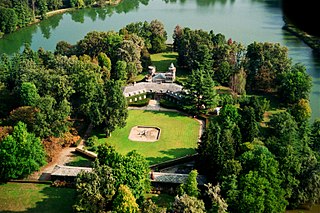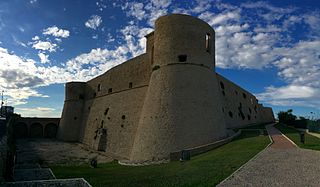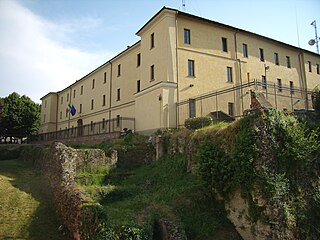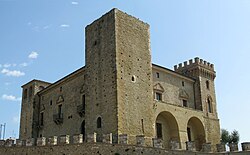
Vigevano is a comune (municipality) in the province of Pavia, in the Italian region of Lombardy. A historic art town, it is also renowned for shoemaking and is one of the main centres of Lomellina, a rice-growing agricultural district. Vigevano received the honorary title of city with a decree of Duke Francis II Sforza on 2 February 1532. It is famed for its Renaissance Piazza Ducale in the centre of the town.

Città di Castello ; "Castle Town") is a city and comune in the province of Perugia, in the northern part of Umbria. It is situated on a slope of the Apennines, on the flood plain along the upper part of the river Tiber. The city is 56 km (35 mi) north of Perugia and 104 km (65 mi) south of Cesena on the motorway SS 3 bis. It is connected by the SS 73 with Arezzo and the A1 highway, situated 38 km (23 mi) west. The comune of Città di Castello has an exclave named Monte Ruperto within Marche.

Vasto is a comune on the Adriatic coast of the Province of Chieti, in southern Abruzzo, Italy. During the Middle Ages it was called Guastaymonis, Vasto d'Aimone or Waste d'Aimone. Fascist Italy called the city Istonio, but it was renamed Vasto in 1944.

The province of L'Aquila is the largest, most mountainous and least densely populated province of the Abruzzo region of Italy. It comprises about half the landmass of Abruzzo and occupies the western part of the region. It has borders with the provinces of Teramo to the north, Pescara and Chieti to the east, Isernia to the south and Frosinone, Rome and Rieti to the west. Its capital is the city of L'Aquila.

The province of Chieti is a province in the Abruzzo region of Italy. Its provincial capital is the city Chieti, which has a population of 50,770 inhabitants. The province has a total population of 387,649 inhabitants as of 2017 and spans an area of 2,599.58 square kilometres (1,003.70 sq mi). The province contains 104 comuni. Its provincial president is Mario Pupillo.

The Castello Sforzesco is a medieval fortification located in Milan, Northern Italy. It was built in the 15th century by Francesco Sforza, Duke of Milan, on the remnants of a 14th-century fortification. Later renovated and enlarged, in the 16th and 17th centuries it was one of the largest citadels in Europe. Extensively rebuilt by Luca Beltrami in 1891–1905, it now houses several of the city's museums and art collections.

Finale Ligure is a comune on the Gulf of Genoa, in the province of Savona, in Liguria, Italy. It is considered part of the Italian Riviera. Part of its historical center ("Finalborgo") is one of I Borghi più belli d'Italia.

Celano is a town and comune in the Province of L'Aquila, central Italy, 120 km (75 mi) east of Rome by rail.

Atessa is an municipality in the province of Chieti, Abruzzo, south-eastern Italy. It is part of the Val di Sangro mountain community. It is the largest municipality in the province by extension and eighth by population.

Casoli a comune and town in the Province of Chieti in the Abruzzo region of Italy. It is situated on a foothill of the Majella mountain, at the base of which runs the Aventino River, tributary of the Sangro. As of 31 December 2004, it had a population of 5,901 and an area of 66 square kilometres (25 sq mi).

Bugnara is a comune and village in the province of L'Aquila in the Abruzzo region of southern Italy. It is one of I Borghi più belli d'Italia.

Camino is a comune (municipality) in the Province of Alessandria in the Italian region Piedmont, located about 45 kilometres (28 mi) east of Turin and about 40 kilometres (25 mi) northwest of Alessandria. As of 31 December 2004, it had a population of 763 and an area of 18.4 square kilometres (7.1 sq mi).

The Castello di Lombardia is a castle in Enna, Sicily. It is one of the largest and most ancient edifices in Italy, with an area of some 26,000 m2 (280,000 sq ft)

La Mandria Regional Park is a park in the comuni of Venaria Reale and Druento, near Turin, northern Italy. Founded in 1978 by the regional council of Piedmont, it occupies a wide area between the Stura di Lanzo torrent and the north-western part of Turin and Venaria.

Castello aragonese is a Renaissance castle in Ortona, Province of Chieti (Abruzzo).

Castello di Ocre is a medieval castle in Ocre, Province of L'Aquila, Abruzzo, southern Italy.

Castello Masciantonio is a Renaissance castle in Casoli, Province of Chieti (Abruzzo).

Castello di Roccascalegna is a medieval castle in Roccascalegna, Province of Chieti, Abruzzo, southern Italy.

The Ducal Castle of Carpineto Sinello is a Renaissance castle in Carpineto Sinello, province of Chieti, Abruzzo, southern Italy.

The Visconti Castle of Lodi is a historical building in Lodi, Lombardy, northern Italy. As it appears today, it is the result of transformations made on a Middle Age castle founded in the 12th century by Frederick Barbarossa. Its name derives from the Visconti family, lords and dukes of Milan, who in the 13th and 14th centuries took possession of and then rebuilt the original fortification.





















